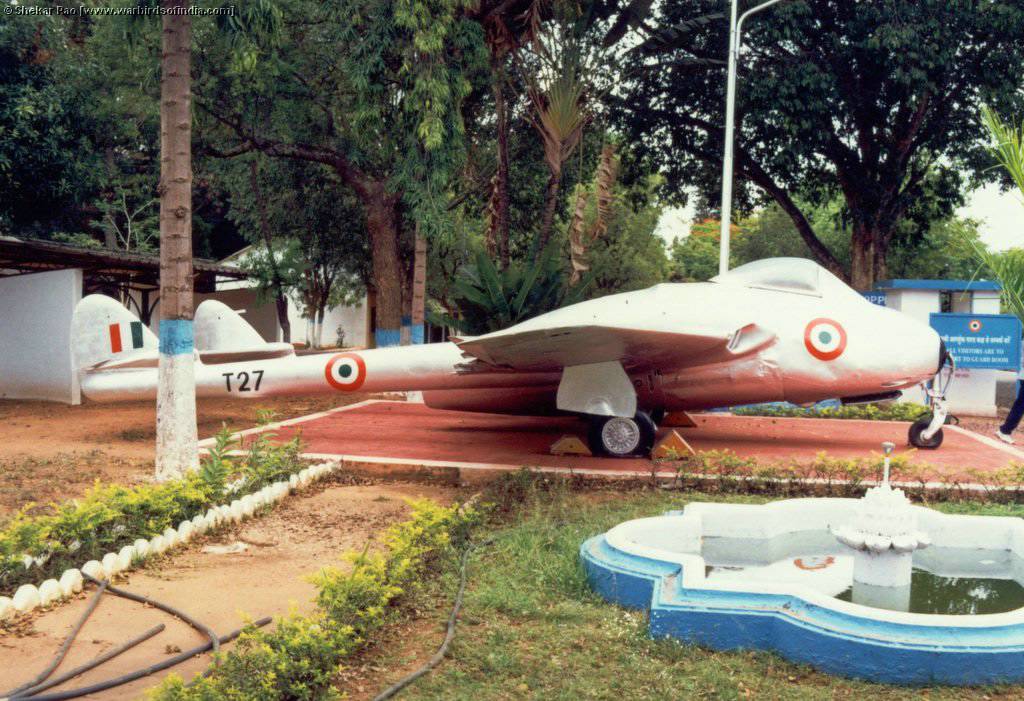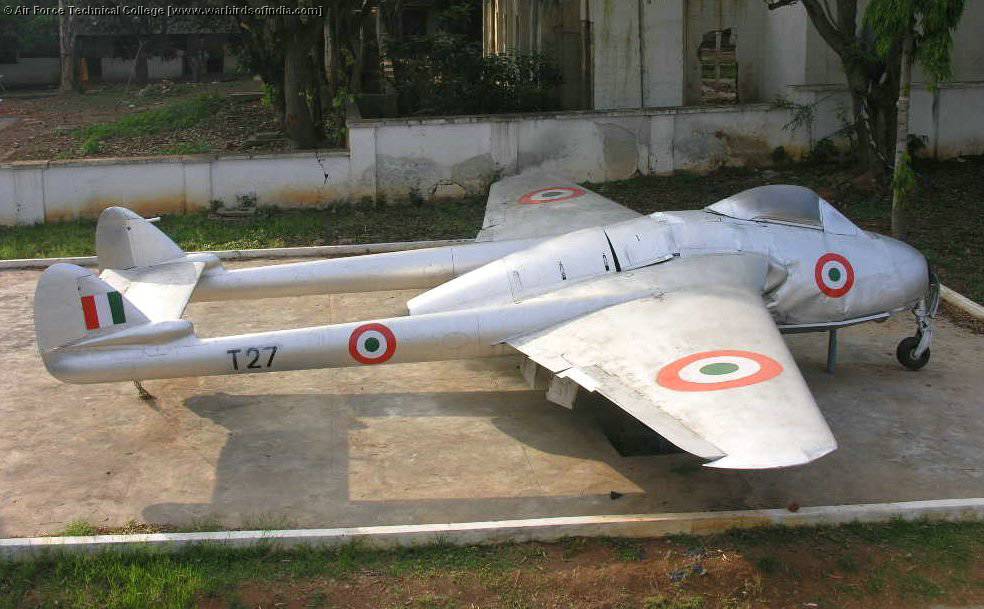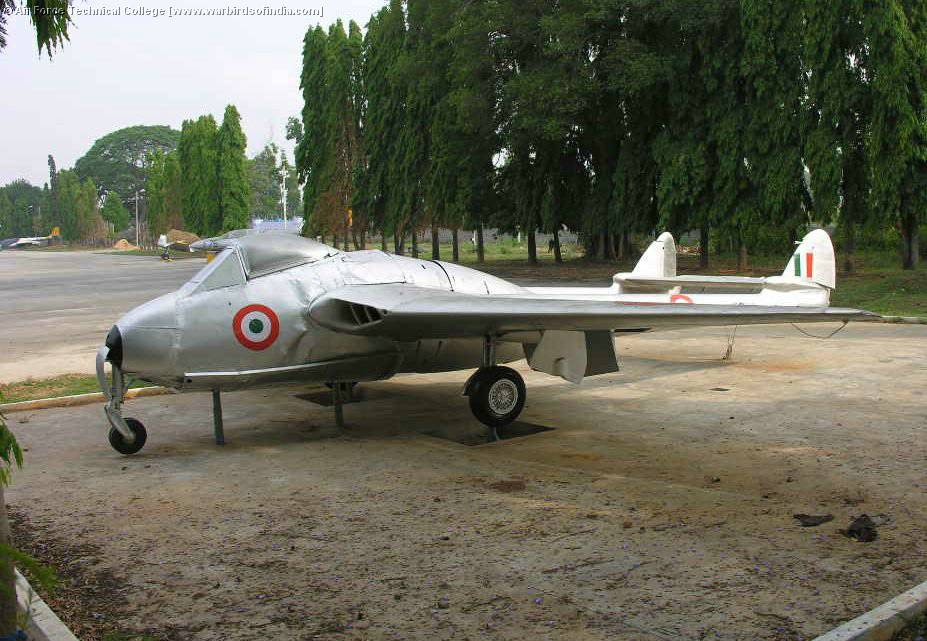Eds Note: Since this is the last update of the year, we have gone thru all our entries and decided our ‘WDY 2005’
For over four decades the Vampire airframe in the college was doing duty under a pseudonym T-27 . No one knew where the aircraft came from and no one knew about its past history. The aircraft had for a couple of decades done duty as the Gate Guardian at main guard room. All the years in the open has not done it much good. The aircraft’s forward fuselage was disintegrating after exposure to years of sun and rain.
A couple of years ago, the aircraft was moved to the Parade Ground of the college. And it had been lying there since. A small cradle like support tray was built for the forward fuselage to give it some semblance of support.
From as far as public memory goes, the aircraft was marked ‘T-27’. The actual identity of the Vampire was unknown…. till early 2005 when WarbirdsofIndia.com helped unveil its actual identity and its place in history.
At the beginning of 2005, in preparation for the sound and light show at Jalahalli, the Vampire was being prepared for the display. Efforts were made to try and find out when and where the aircraft came from. But the records at AFTC revealed nothing. No documentation or records existed as to when the Vampire was taken on charge or from where it came. Its original serial number had been lost over the years under layers and layers of silver paint and the ubiquitous training number ‘T-27’.
The crew at AFTC then decided to disassemble all the loose panels and search for any data plates or stencilled markings. While no data plates were found, one of the engine panels did turn up the numbers ‘VV211’ painted on the inside. This was the clue that helped unveil the aircraft’s amazing history. Without a doubt, VV211 was the RAF Serial of the Vampire. The aircraft was probably one of the original RAF delivery aircraft. But which one?
So one fine evening we receive an email from AFTC asking us to find out about VV211. The moment we saw the serial number as VV211, we knew. We knew this was no ordinary FB52. This was a historic airframe. VV211 was nothing but one of the first three Vampire F.3s in the IAF service. Hell, VV211 was one of the first ever Jet fighters flown by any Asian Air Arm!
When the Indian Air Force decided to induct the De Haviland Vampire Mk 5s into service in 1948, it was decided to send three Vampire F.Mk.3 fighters to the newly formed Aircraft Testing Unit at Kanpur. In November 1948, three Vampire F3s were flown by British Test Pilots to New Delhi’s Safdarjung Air Field, and received by the Air Force CinC Air Marshal T W Elmhirst and the then prime minister Shri Jawarharlal Nehru himself. The three Vampires were marked in an unusual marking, all three carried a Civilian VT registration, Chakra markings and the newly allocated IAF Serials. Thus the aircraft were:
1. VV209 – VT-CXH – HB544
2. VV210 – VT-CXI – HB545
3. VV211 – VT-CXJ – HB546
The aircraft was flown extensively by the ATU, under the command of Sqn Ldr D Subia VrC. Flying with him were Flt Lt Micky Blake, Fg Offr Nobby Clark and Fg Offr G V Kuriyan. After a year or so of testing and flying across the whole of the country and showing the flag, the ATU was merged into No.7 Squadron ‘Battle Axes’, then flying Spitfire XVIIIs. In early 1951, the Vampires F3s were replaced by the FB52s freshly arriving from the UK. No one knew about the fate of the three F3s. At least until now.
Referring to David Watkin’s excellent history of the Vampire, We at Warbirdsofindia deduced that the panels were definitely from HB546. But is the aircraft itself the F3 that we wanted it to be? Because there is always the possibility that the panels were changed with an FB52 at some point of time.
We were assured by many that interchanging of panels was not that easy and that the panels in most cases did not fit on other aircraft. That can only be confirmed if the aircraft sported the rounded wingtips of the Mk3 instead of the straight-clipped wingtips of the FB52. An email and 24 hours later, photographs of the Vampire arrived – that showed the rounded wingtips! Time for celebration!
Once the identity of VV211 was established and confirmed by AFTC, the college lost no time in repainting the aircraft in its original VT-CXJ – Chakra – HB546 markings, and adorned the forward fuselage with the Battle Axe emblem. Thus this aircraft is the only current warbird in India to sport the Chakra markings. However, the aircraft features the standard Tri Color roundels on the wings, perhaps an oversight by the painters, or a reminder of its original anonymous scheme.
The F3 is currently displayed on the right end of the AFTC Parade ground. Some minor repairs have been carried out on the aircraft, like removing the dents in the tail boom etc. But the forward fuselage is too badly deteriorated to be repaired successfully. So the aircraft currently sports a cradle-like structure supporting the area.



The emergence of one of the first-ever Vampires from the cold and the interest in preserving its history and identity definitely proves that the Indian Air Force is one of the leading players in the Vintage Aircraft History movement in India.





